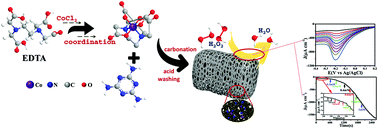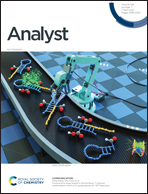Cobalt and nitrogen co-doped mesoporous carbon for electrochemical hydrogen peroxide sensing: the effect of graphitization†
Abstract
In this study, a facile strategy for the scalable synthesis of cobalt and nitrogen co-doped mesoporous carbon (Co–N/C) is reported. Structural characterization demonstrated that Co and N were successfully co-doped in the highly porous carbon. Graphitization of porous carbon was achieved by the introduction of cobalt species. The degree of graphitization of Co–N/C could be further promoted by increasing the calcination temperature. By taking advantage of the excellent mass and electron transfer kinetics attributed to the high specific surface area, high porosity and high graphitization, the obtained Co–N/C exhibited good electrochemical activity towards H2O2 reduction and excellent sensing performance for the electrochemical detection of H2O2. The Co–N/C-950 catalyst obtained at 950 °C showed good electrochemical sensing performance with a detection limit of 2 μM and a wide linear response over the concentration range from 0.03 mM to 13 mM. Meanwhile, Co–N/C exhibited high selectivity toward the detection of H2O2 in the presence of possible interferences during the applications such as NaCl, glucose, ascorbic acid and so on. The results confirm that Co–N/C could be used as an efficient electrocatalyst to fabricate electrochemical sensing devices.



 Please wait while we load your content...
Please wait while we load your content...